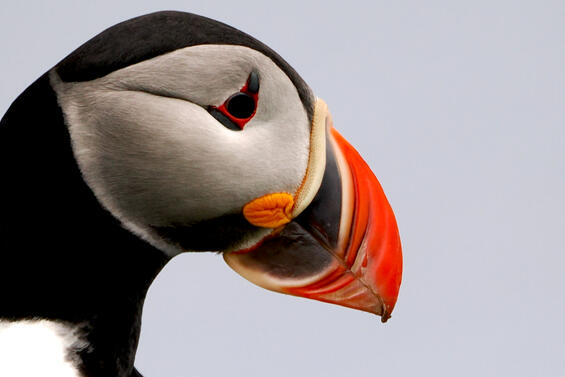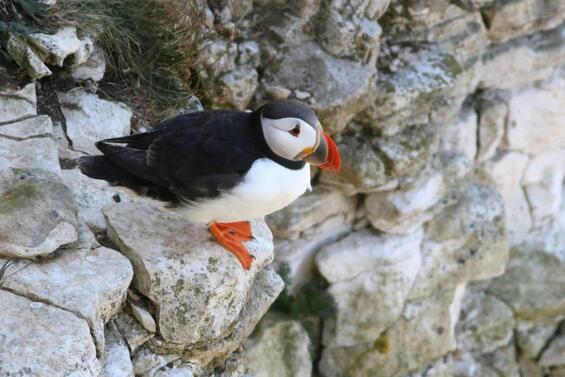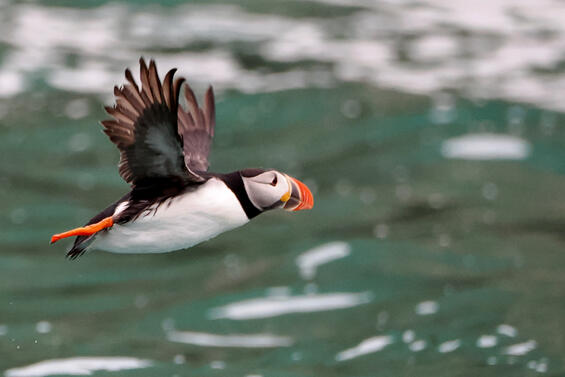- Scientific name: Fratercula arctica
Species of Greatest Conservation Need (MA State Wildlife Action Plan)
Description

Atlantic puffin (Fratercula arctica)
Atlantic puffins are stocky and medium-sized alcids that have black backs and wings, a white belly, and a large yellow and orange beak. Atlantic puffins are stocky and medium-sized alcids that have black backs and wings, a white belly, and a large yellow and orange beak. In breeding plumage, their bill becomes laterally flattened and brightly colored, and they develop distinctive grayish face patches and fleshy rosettes at the base of the bill. Their short wings are adapted for “flying” underwater, using rapid strokes to pursue prey.
Life cycle and behavior
Atlantic puffin breeding phenology varies with colony latitude. Adults arrive at the colony and begin repairing, reclaiming, and excavating burrows. Egg laying also varies with latitude but typically spans from mid-April through May. Puffins lay one egg per clutch and one brood per season. Both adults incubate eggs for roughly 39 – 42 days. Chicks are semiprecocial at hatch and covered in fluffy dark down. Adults brood chicks for around 9 days old. Both parents provision chicks. The chick-rearing period differs among colonies and ranges from 38 – 50 days. Young puffins usually leave their burrows at night. Following the breeding season, Atlantic puffins disperse to offshore areas. In the Gulf of Maine, puffins forage on a variety of fish and young are fed smaller species (e.g., herring, hake, and sand lance). Age at first breeding is usually 3-5 years.

Atlantic puffin (Fratercula arctica)
Population status
Atlantic puffins are listed as vulnerable by the International Union for Conservation of Nature. The global Atlantic puffin population is estimated at 12,000,000–14,000,000 mature individuals. Although population estimates are limited, its suspected that the population is decreasing. Historically, populations declined as puffins were exploited for feathers and food (e.g., egging, hunting).
Distribution and abundance
During the breeding season, Atlantic puffins are found in the North Atlantic from 50°N to 80°N. Outside of the breeding season, they can be found south to southern Europe, western Mediterranean, and the east Atlantic Islands. Atlantic puffins can be seen off the coast of Massachusetts outside of the breeding season.

Habitat
Atlantic puffins breed on islands and rocky cliffs off the coasts of North America, Europe, and Asia. They need on grassy-turfed maritime slopes, sea cliffs, boulder fields, and scree slopes. Nonbreeding habitats are not well known. They are found generally in offshore and pelagic habitats within their breeding ranges. Atlantic puffins can be seen foraging off the Massachusetts coast between May and October.
Healthy habitats are vital for supporting native wildlife and plants. Explore habitats and learn about conservation and restoration in Massachusetts.

Atlantic puffin perched on a rocky cliff, a typical nesting habitat for this species.
Threats
Atlantic puffin declines are likely a result of several factors that threaten their populations. These include entanglement in fishing gear, a reduction in their food resources as a result of over-fishing, ecological changes associated with climate change, invasive nest predators that have been introduced to islands with large nesting colonies, oil pollution, direct exploitation (e.g., harvesting eggs, chicks, adults), and threats associated with development and energy production (e.g., wind turbines). Recently, some breeding populations have experienced widespread nesting failure as a result of chick starvation, which is thought to result from climate change. Plastic trash in the environment poses a threat as it can be mistaken as food by seabirds and shorebirds and ingested or cause entanglement. Ingested plastics, common for seabirds, can block digestive tracts, cause internal injuries, disrupt the endocrine system, and lead to death. Entanglement from fishing gear and other string-like plastics can cause mortality by strangulation and impairing movements.

An Atlantic puffin in flight over coastal water.
Conservation
Aside from the projected recent population declines, Atlantic puffin populations increased after the 1900s following increased protection. Populations typically nest in protected sanctuaries where harvesting is prohibited. Monitoring and protection of populations take place at several colonies. Additionally, several chick translocation efforts on extirpated colonies in the Gulf of Maine were successful.
Continued efforts are needed to control and remove invasive species and reduce human disturbance at the breeding colonies. Further research is needed to understand wintering locations and associated threats, as well as the impact of food shortages on populations.\
Avoid or recycle single-use plastics and promote and participate in beach cleanup efforts.
References
Lowther, P. E., A. W. Diamond, S. W. Kress, G. J. Robertson, K. Russell, D. N. Nettleship, G. M. Kirwan, D. A. Christie, C. J. Sharpe, E. Garcia, and P. F. D. Boesman. “Atlantic puffin (Fratercula arctica), version 1.0. In Birds of the World (S. M. Billerman, Editor)”. 2020. Cornell Lab of Ornithology, Ithaca, NY, USA
BirdLife International. “Species factsheet: Atlantic puffin Fratercula arctica.” 2018. BirdLife International.
Contact
| Date published: | May 13, 2025 |
|---|